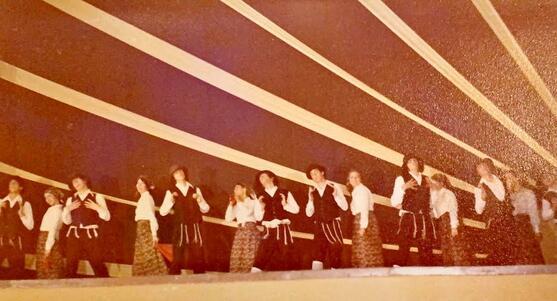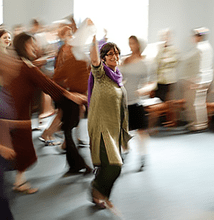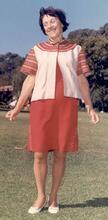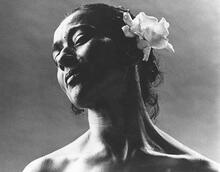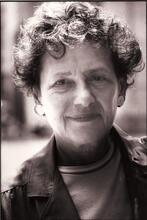Jewish Women and Israeli Dance in Brazil
Israeli dance is a cultural expression from Israel that has been disseminated in many countries and has become a traditional sociocultural habit in many Diaspora Jewish communities. In Brazil, many women have had a fundamental role in the evolution and development of Israeli dance amid their Jewish communities. Some of them have been pioneers in this process. Others have been important for their continued dedication to the preservation and practice of this tradition within their communities.
Israeli dance is a Jewish cultural expression that emerged in the twentieth century leading up to and surrounding the foundation of the State of Israel. It was derived from dances from various Jewish ethnic groups of the Lit. (Greek) "dispersion." The Jewish community, and its areas of residence, outside Erez Israel. Diaspora ; catalyzed by the Zionist movement that started in the late nineteenth century, it then migrated to Israel. Today these dances are seen not only as characteristic of the peoples who composed the new State, but also as part a complex system known as Israeli dance.
Israeli dance developed rapidly, due to the efforts of people who organized processes that facilitated the promotion, development, and dissemination of the dance culture then prevalent in the land of Israel. It also spread around the world, as community leaders in the Diaspora invested in promoting Israeli dance because of its link with Jewish identity. Women played major and pioneering roles in the development and current practice of Israeli dance both in Israel and in the Diaspora. Some contemporary Brazilian Jewish women have been dedicated to preserving Israeli dance in their communities for over 30 years.
Israeli Dance Pioneers
In Brazil, many women have played fundamental roles in the establishment and development of Israeli dance as a sociocultural practice. In 1963, a group of friends gathered to create a dance group set to folkloric Jewish music. The group they formed in São Paulo, Conjunto Folclórico Chinani (Folkloric Group Chinani, named after the first song they rehearsed, Tapuach Chinani, or Sweet Apple), was the first group in Brazil dedicated to choreography of Israeli dance for regional and national events. Its meetings and rehearsals took place at CIP - Congregação Israelita Paulista (Jewish Congregation in São Paulo). The group included musicians, a choir, and dancers; it later inserted recital of texts and poems into its artistic productions as well. Its choreographer, Patrícia Finzi (b. 1943), was the first Israeli dance choreographer in Brazil in an official group. For two years, it performed quite intensely, invited to present in Jewish events and non-Jewish venues interested in international and ethnic practices. The group performed in São Paulo, Rio de Janeiro, Minas Gerais, Paraná, Rio Grande do Sul, Santa Catarina, Brasília, and elsewhere.
The first Israeli dance festival in Brazil was organized in Rio de Janeiro by Rosete Roizenblit Rubin (b. 1938). In 1972, Rubin started working as the director of Jewish culture for Clube Hebraica - Sociedade Cultural Esportiva e Recreativa (Hebrew Club: Cultural, Sporting and Recreational Society). When leaders of Jewish Zionist youth movements requested a place in the institution where they could do their performances of Israeli dance, Rubin, who had earlier worked as a teacher of the art form, was immediately supportive. Her one condition was that the event be recognized as part of the Club. Clube Hebraica then organized the first Festival de Dança Israeli (Israeli Dance Festival). The following year, groups from various Brazilian states expressed interest in taking part, and the festival’s name was changed to FENDI - Festival Nacional de Dança Israeli (Israeli Dance National Festival). Wanting a background song to serve as the festival’s brand, Rubin selected the traditional song “Hava Netze Bemachol” (Let´s get out in dance), which she had heard when passing by a rehearsal of another group. The song’s name was added to the festival’s title, and Hava Netze Bemachol is now not only a national festival but international as well, often including groups from outside Brazil.
In 1982, Frida Zalcman (b. 1959) created the first course in Brazil to train Israeli dance teachers and choreographers, in Rio de Janeiro. She had lived for some years in Israel, where she received a degree in dance from the Seminar Hakibbutzim College in Tel Aviv and experienced Israeli dance intensely. Back in Brazil, Zalcman recognized the need for teachers and choreographers to deepen their studies of the historical, anthropological, aesthetic, scenic, and physical aspects of Israeli dance. She was able to offer the course with support from OSURJ - Organização Sionista Unificada do Rio de Janeiro (Unified Zionist Organization of Rio de Janeiro) which supplied the space and infrastructure and paid for professionally qualified teachers. The course, which lasted one year, issued professional certification to the students who completed it. Three classes were formed in this course, while in other states similar initiatives were carried out in later years. Unfortunately, these classes do not exist today.
In Curitiba, Ieda Bogdanski (b. 1961) laid the foundation for Israeli dance training of children and youth. Bogdanski began participating in Israeli dance at fourteen years old as a dancer in the Kineret Group at the Centro Israelita do Paraná (Paraná Jewish Center). She had not started earlier because no classes existed for a younger audience. In 1977, while in charge of a camping activity for a youth Jewish movement, she taught one Israeli dance class for older children and young teenagers. When they returned from camping, the group requested that she continue the class. Her Kineretinho (little Kineret) group for children and youth was supported by the Centro Israelita do Paraná. By 1978, Kineretinho was traveling to perform at the Israeli dance festival in Rio de Janeiro. Later, the name was changed to Haemek, from a traditional folkloric work by Israeli choreographer Yonatan Karmon, of whom Bogdanski was fond, that was part of the Kineret Group repertoire. In 1985, Kineret Group ceased to exist and Haemek took responsibility for representing Curitiba in Israeli dance. The group was now made up of adult dancers. However, Bogdanski’s initial proposal for Kineretinho convinced the Jewish community of Curitiba of the importance of Israeli dance for children and youth. Today there are many Israeli dance groups for young people in Curitiba.
In Recife, Esther Sara Feldmus Jaroslavsky (1921-1985) fostered the beginning of Israeli dance culture. Married to Salomão Jaroslavsky, who served for 50 years as Honorary Consul of Israel in the northern and north-eastern regions of Brazil and was the president of Federação Israelita de Pernambuco (Jewish Federation of Pernambuco), she was a member of a philanthropic group of politicians and consuls' wives in Pernambuco. One of the group’s projects was Festa das Nações (Nations Party), whose proceeds were to be donated to charity. This event was split into two parts: an exhibition of booths, with typical food, crafts, and objects from each cultural group, and a presentation of traditional dances from various countries. Jaroslavsky was in charge of the Israel section; she organized a group of women to create the booths and formed an Israeli dance group to present in the show.
Jaroslavsky rehearsed at the Colégio Israelita Moises Chwartz (Moises Chwartz Jewish School), attended by all the dancers in the group, who were between the ages of fifteen and eighteen. Initially intending only to present at the Festas das Nações, by 1968 the group was an important representative of Recife’s Jewish community and presented at both Jewish and multicultural events. It became known as the Grupo Folclórico da Federação Israelita de Pernambuco (Folkloric Group of the Jewish Federation of Pernambuco) and lasted for a decade, performing in many spaces in Recife as well as in other states of Brazil. After it ceased to exist, Jaroslavky’s legacy in Israeli dance continued through later groups in Recife, such as Aviv and Ietzirá. The Aviv group was founded by three ex-dancers from Jaroslavsky: choreographers Gina Schvartz Saffer (b. 1959), Liliane Mizrahi (b. 1960), and Sulamita Schoze (b. 1960).
Judite Gantman (b. 1951) was the first choreographer for the respected Israeli dance group Kadima, the first such group in Porto Alegre. Members of the Porto Alegre Jewish community were inspired to create an Israeli dance group after attending a performance of the Kineret Group, from Curitiba. In 1979, in the 1º. Seminário de Dança Folclórica em Ingá-SP (1st Folkloric Dance Seminar in Ingá-SP), they met Gantman and convinced her to move from São Paulo to Porto Alegre. Gantman faced the challenge of preparing a cast that needed basic preparation in order to perform Israeli dance. She had to take charge of tasks including scenic production, choreography, teaching, design, and costumes. The group’s premiere, “From Gail to Negev,” occurred on the 32nd Anniversary of the State of Israel on May 12, 1980, at Teatro Leopoldina (today the Teatro da OSPA - Orquestra Sinfônica de Porto Alegre, or OSPA Theater - Symphony Orchestra of Porto Alegre); the Kineret Group, which inspired the Kadima Group, also performed. Gantman’s choreography, such as “Dodi dodi,” “Ha Teimanim Ba Aretz,” “Chaguigá Ba Kfar,” and E”lem ve Susato,” left an important mark on the Kadima Group, which is currently known for its longevity and high artistic quality. Even though Gantman worked with the group for only one year, she is recognized as having planted the seed for its growth.
Longest-Serving Israeli Dance Teachers and Choreographers
Adriana Gordon Paves (b. 1967) has worked as an Israeli dance teacher in the city of São Paulo since the 1980s. She is intensely dedicated to harkadot (Israeli circle dances), organizing events and teaching many Jewish and non-Jewish groups of various ages. Paves has played many roles at Clube “A Hebraica” de São Paulo ("Hebrew" Club of São Paulo) and Círculo Esportivo Israelita Brasileiro Macabi (Macabi Jewish Sports Circle in Brazil), coordinating festivals and articulating strategies for developing of Israeli dance in the community. She is also well known as a group choreographer.
Paves has accomplished something that no Israeli dance choreographer has done in Brazil: leading her Ofakim Group, founded in 1985, for over 35 years with largely the same cast. The group started as an Israeli circle dance group with classes for adults. In 1985, when not yet a performance group, the dancers invited to perform at an event at the Sociedade Beneficente Israelita Brasileira Talmud Thora-Lubavitch (Talmud Thora-Lubavitch Jewish Beneficent Society in Brazil); in 1986, it was motivated to develop choreography as well. Of the cast of 31 people in 2021, at least 20 have been performing since the group’s first decade. Paves recognizes that for the cast members, being part of this group means more than simply dancing the choreography and performing on stage; Ofakim may be considered an adult Jewish movement, comparable to Jewish youth movements. Members have built among an important community with many shared experiences, and this social fuel keeps it active and sustains its important presence in Israeli dance events.
Elana Waistein Fridman (b. 1964) has dedicated her professional career (as dancer, choreographer, teacher, and educational coordinator) to training many generations of dancers in Porto Alegre. She started her career as a dancer for the Kadima Group in 1979, becoming its main choreographer ten years later. For the twenty years she headed the group, her works stood out in the Israeli dance scene not only in Porto Alegre but all over Brazil. With a distinct style, blending drama elements with folkloric dance, she has developed a remarkable choreographic language. These features are also present in her choreography for Ameinu, which she founded in the 1980s for thirteen- and fourteen-years-old students and continues to run today. Fridman was also part of the team responsible for implementing Israeli dance as a regular subject in the Colégio Israelita Brasileiro (Jewish School in Brazil), in 1984. The principal of the school at that time was Paulina Silbert (b. 1943). Part of the school's Jewish education curriculum, the weekly Israeli dance classes develop the students’ experiential connection of values and Jewish themes. For over 30 years Fridman has helped to coordinate Jewish education at the school, training and supporting Israeli dance teachers.
Fridman considers Israeli dance as an essential tool in the construction of Jewish identity; in her hands, it transcends the teaching of movement to become an efficient tool for Jewish education. Fridman argues that this Jewish folk practice provides individuals with self-recognition, develops a sense of belonging, and promotes human growth and development.
Award-winning performance of Brazilian Israeli dancer Sandra Libaber’s choreography “Lehakat Habonim” for the Habonim Dror youth movement’s dance group, at the 1992 Hava Netze Bemachol Festival.
In Rio de Janeiro, chance led Sandra Libaber (b. 1973) to a long career as an Israeli dance teacher and choreographer. In 1992, not intending to become a choreographer, she was invited, together with Renata Bucaresky (b. 1973) (currently a choreographer in the United States), to lead the dance group of the youth Jewish movement Habonim Dror. Her choreographic work won second place in the Hava Netze Bemachol Festival, in which amateur and professional groups competed equally that year. Such an award for an amateur group brought her sudden visibility. Immediately thereafter, when she was picking up her records at the Eliezer Steinbarg Jewish school where she had studied, the principal invited her to teach Israeli dance at the school. In addition to holding this position for 30 years, she has also worked for other Jewish schools, including the Colégio Israelita Brasileiro A. Liessin Scholem Aleichem (A. Liessin Scholem Aleichem Jewish School in Brazil) and the Associação de Ensino e Cultura TTH-Barilan (TTH-Barilan Culture and Education Association). She has also worked for other Jewish institutions, such as Clube Hebraica and ASA - Associação Scholem Aleichem (Scholem Aleichem Association).
Libaber was also in charge of the general direction of the Hava Netze Bemachol Festival in 1999 and 2000, but what really motivates her in Israeli dance is the relationship with the creative and with teaching. She constantly produces choreographic works for Israeli dance festivals, which always rely on the presence of her groups. Currently, Libaber is one of the only teachers who preserving Israeli circle dance culture in Rio de Janeiro.
Conclusion
In the third decade of the twenty-first century, Israeli dance in Brazil is a well-established cultural phenomenon, outstanding even in the international community. The Carmel Festival in Brazil, established in 1980 and now directed by Nathalia Leiderman Benadiba (b. 1981), is the largest Israeli dance festival outside of Israel; groups from various parts of the world participate, including Israel, the United States, Mexico, Panama, Uruguay, Argentina, and Chile. A new generation has boldly represented Brazil at international Israeli dance events. Marina Victoria Halsman Serwaczak (b. 2005), trained by Sharon Catach Feinstein Bacal (b. 1985), an important teacher from São Paulo, represents this new generation. The Covid pandemic, which prevented in-person events, boosted virtual meetings among Jewish communities worldwide for the practice of Israeli circle dances. Some of these events last over 24 hours, engaging Israeli dance teachers from approximately 40 countries. The teenaged Serwaczak is always invited to represent Brazil on these occasions. Women have thus taken important roles in the history of Israeli dance in Brazil, acting as pioneers, training generations of dancers, and continuing to be responsible for preserving and perpetuating this cultural phenomenon.
Espíndola, Susana Sondermann. Nos passos do Kadima: a dança Israeli no Rio Grande do Sul. Porto Alegre: Fundação Israelita Brasileira de Arte e Cultura Kadima, 2005.
Freinquel, Paola and Gabriela Wilensky. Danzas folkloricas israelies: la experiência argentina. Buenos Aires: Milá, 2002.
Friedhaber, Zvi. Gurit Kadman, Mother and Bride. Jewish Dance Archive: 1990.
Kadman, Gurit. A Nation Dances. Jerusalem and Tel Aviv: 1969.
Kadman, Gurit. Ethnic Dances in Israel (Hebrew). Givatayim: 1982.
Most of the information of this article was gathered from interviews conducted by the author either with the personalities addressed here in the text or with their direct relatives, by Zoom video platform from January 23 to March 12, 2021.





